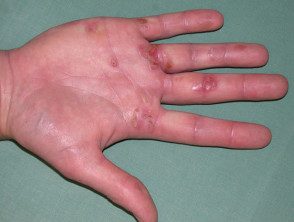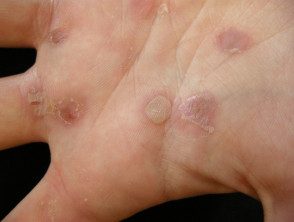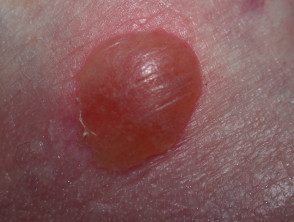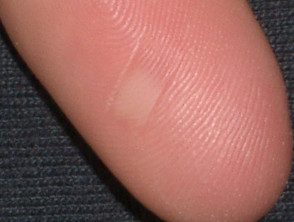What is a friction ampoule?
A friction blister is a blister caused by skin that is repeatedly rubbed against another object. It most often forms on the palms, fingers, soles, sides of the feet, and toes. The top of the blister is rubbed where the skin is thinner, such as the top of the hand or foot, forming an abrasion. On thinner skin areas, friction rubs without blistering.
What causes the friction blister?
A friction blister occurs when there is contact, pressure, and movement between the skin and something that touches it, such as a heel rubbed by a new or unfamiliar shoe.
Pure forces cause the mechanical separation of the layers of epidermal cells. The gap fills with fluid, forming a subepidermal. bulla (blister). A blister forms more quickly if the pressure and movement on the skin is severe or if the skin is wet.
Who gets friction blisters?
Friction blisters occur occasionally in almost men and women of all ages. Exacerbate factors include:
- Heat: they are particularly predominant in tropical climates.
- Long or vigorous exercise: they are common in athletes (especially marathon runners) and soldiers; A third of the 872 US soldiers surveyed in Iraq had blisters.1 Blisters on the palms can arise when paddling, or in children playing on monkey bars.
- Carrying a heavy load increases the risk of blisters.
- Excessive sweating - hyperhidrosis softens the skin so that the skin divides more easily.
- Tight, uncomfortable, or new shoes that rub repeatedly on one or two areas of the skin.
- Non-absorbent or thin socks: they do not absorb moisture well and do not adequately protect the skin from damage caused by shoes or boots.
- Rough or hard fabrics can cause blisters elsewhere, such as armpits or groin.
Blisters can also arise in pressure areas such as the hip, as a complication of surgery or loss of consciousness, classically after barbiturate poisoning.
There are some specific diseases that make the skin more fragile than usual, and also cause blisters in response to friction or injury.
- Genetic Arrangement: Epidermolysis Bullosa is a group of disorders in which the skin easily blisters.
- Immunobullous disease - acquired epidermolysis bullosa.
- Metabolic disease - delayed cutaneous porphyria
- Sun damage - especially overexposure to solaria or tanning beds
- Certain medications: pseudoporphyria due to nonsteroidal anti-inflammatory drugs or antibiotics (doxycycline)
What are the clinical characteristics of the friction ampoule?
Rubbing on the skin first peels off the surface cells. More pressure makes the affected skin red, hot and itchy. The red skin turns pale as the blister forms. The ampoule usually contains clear liquid, but the bleeding changes the color to red / brown.
Blisters occur where the stratum corneum (the outer cell layer) is very thick, as is the case on the sole of the foot and the palm of the hands. Where the skin is thinner, friction tends to come off epidermis completely, resulting in a erosion (sore).
If the ampoule remains intact, the fluid will be reabsorbed and the damaged skin will peel off a few days later.
Friction ampoules

Friction ampoules

Friction ampoules

Friction ampoules

Friction ampoules

Friction ampoules

Friction ampoules
Should I have a test?
Testing is not necessary for typical friction blisters. The following investigations may be considered when the blisters are frequent, extensive, or do not heal.
- Hispa to verify bacterial infection with Staphylococcus aureus or Streptococcus pyogenes (impetigo or cellulite).
-
Skin biopsy of a new friction ampoule for histopathology reveals intraepidermal divided without inflammation. Specific characteristics may lead to another diagnosis.
- Live skin biopsy immunofluorescence, positive in immunobullous diseases, is negative in the friction blister.
- Genetic testing may be requested if epidermolysis bullosa is suspected.
Friction blister complications
Intact friction blisters generally heal quickly without scarring. Healing is sometimes delayed. Problems may include:
- Pain that hinders performance
-
Wound infection - presents with increased pain and redness around the blister / erosion, a red streak going into the groin or armpit, and pus formation. The infection is more common in diabetics and immunodeficient individuals.
- Pyogenic granuloma occasionally it may arise at the site of a blister a few days later.
- Scarring due to infection or deeper injury.
How should I treat a friction ampoule?
The friction blisters will heal on their own. However, dressings are useful to protect against further damage. Hydrocolloid ampoule strips can promote faster healing.
Large blisters can be drained by pricking with a sterile needle. If possible, it is best to keep the top of the blister in place, to reduce pain and decrease the chance of infection. If the top of the blister has come off leaving an eroded skin surface, carefully clean the wound and apply a clean bandage.
Infected friction blisters or erosions It may require current Antibiotics or antiseptics for a few days. Systemic Antibiotics should be used if cellulite occurs. Antibiotics should not be used if the wound is not infected.
Can I avoid friction blisters?
If you are prone to friction blisters, the following measures may be helpful.
- Well-fitting boots and shoes; wear orthoses if necessary to reduce pressure points.
- Neoprene insoles
- Moisture wicking socks, changed as soon as they are wet
- 2 pairs of socks: thinner polyester inner layer and thicker wool or polypropylene outer layer
- Leggings to prevent gravel and plant materials from entering the shoe.
- Lamb wool padding on and around blister-prone areas
- Various proprietary padding, cushioning and protective barrier products available over the counter at your local pharmacy
Antiperspirants, petrolatum, or silicone lubrication, powders, and topical skin adhesives have been recommended and may be helpful. However, it has not been scientifically proven to reduce discomfort or improve healing.
A certain hardening occurs with repetitive low intensity exercise due to callus formation (epidermal thickening).

